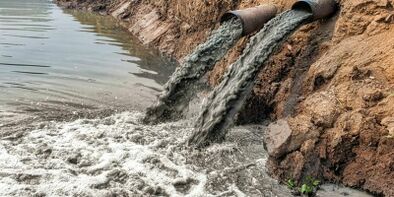Wastewater: различия между версиями
Перейти к навигации
Перейти к поиску

Krastyn (обсуждение | вклад) |
Qqqwww (обсуждение | вклад) |
||
| Строка 6: | Строка 6: | ||
==Определение на английском== | ==Определение на английском== | ||
Used water from any combination of domestic, industrial, commercial or agricultural activities, surface runoff/ stormwater, and any sewer inflow or sewer infiltration.<ref>Tilley E. et al. Compendium of Sanitation Systems and Technologies // Development. 2008. P.180.</ref> | Used water from any combination of domestic, industrial, commercial or agricultural activities, surface runoff/ stormwater, and any sewer inflow or sewer infiltration.<ref>Tilley E. et al. Compendium of Sanitation Systems and Technologies // Development. 2008. P.180.</ref> | ||
| + | |||
| + | Water that has been used in the home, in a business, or as part of an industrial process. | ||
==Пример использования термина на английском языке== | ==Пример использования термина на английском языке== | ||
| Строка 11: | Строка 13: | ||
# Compounds such as pharmaceuticals, or personal care products are only partially removed in wastewater treatment processes.<ref>Rogowska J. et al. Micropollutants in treated wastewater // Ambio. 2020. Vol. 49, № 2. P. 16.</ref> | # Compounds such as pharmaceuticals, or personal care products are only partially removed in wastewater treatment processes.<ref>Rogowska J. et al. Micropollutants in treated wastewater // Ambio. 2020. Vol. 49, № 2. P. 16.</ref> | ||
# This wastewater may contain hazardous materials and requires special treatment or disposal.<ref>https://water.unl.edu/article/wastewater/wastewater-what-it Archived from the original on 5 October 2021.</ref> | # This wastewater may contain hazardous materials and requires special treatment or disposal.<ref>https://water.unl.edu/article/wastewater/wastewater-what-it Archived from the original on 5 October 2021.</ref> | ||
| + | # Wastewater contains nutrients which can stimulate the growth of aquatic plants, and may contain toxic compounds or compounds that potentially may be mutagenic or carcinogenic. For these reasons, the immediate and nuisance-free removal of wastewater from its sources of generation, followed by treatment, reuse, or dispersal into the environment is necessary to protect public health and the environment<ref>Tchobanoglous, George, Franklin L. Burton, and H. David Stensel. "Wastewater engineering." ''Management'' 7.1 (1991): 4.</ref>. | ||
==Перевод использования на русском языке== | ==Перевод использования на русском языке== | ||
| Строка 16: | Строка 19: | ||
# Такие соединения, как фармацевтические препараты или средства личной гигиены, удаляются лишь частично в процессах очистки сточных вод. | # Такие соединения, как фармацевтические препараты или средства личной гигиены, удаляются лишь частично в процессах очистки сточных вод. | ||
# Эти сточные воды могут содержать опасные материалы и требуют специальной обработки или утилизации. | # Эти сточные воды могут содержать опасные материалы и требуют специальной обработки или утилизации. | ||
| + | # Сточные воды содержат биогенные элементы, которые могут стимулировать рост водных растений, и могут содержать токсичные соединения или соединения, которые потенциально могут быть мутагенными или канцерогенными. По этим причинам для защиты здоровья населения и окружающей среды необходимо немедленное удаление сточных вод из источников их образования с последующей обработкой, повторным использованием или рассеиванием в окружающей среде. | ||
==Список литературы== | ==Список литературы== | ||
<references /> | <references /> | ||
Текущая версия на 01:53, 20 мая 2024
The term is partially related to sewage (see more in discussion).

New wastewater management facilities will soon be established in the governorates of the Red Sea and Assiut in Egypt.[1]
Сточные воды
Дождевые, талые, инфильтрационные, поливомоечные, дренажные воды, сточные воды централизованной системы водоотведения и другие воды, отведение (сброс) которых в водные объекты осуществляется после их использования или сток которых осуществляется с водосборной площади.[2]
Определение на английском
Used water from any combination of domestic, industrial, commercial or agricultural activities, surface runoff/ stormwater, and any sewer inflow or sewer infiltration.[3]
Water that has been used in the home, in a business, or as part of an industrial process.
Пример использования термина на английском языке
- Compounds such as pharmaceuticals, or personal care products are only partially removed in wastewater treatment processes.[4]
- This wastewater may contain hazardous materials and requires special treatment or disposal.[5]
- Wastewater contains nutrients which can stimulate the growth of aquatic plants, and may contain toxic compounds or compounds that potentially may be mutagenic or carcinogenic. For these reasons, the immediate and nuisance-free removal of wastewater from its sources of generation, followed by treatment, reuse, or dispersal into the environment is necessary to protect public health and the environment[6].
Перевод использования на русском языке
- Такие соединения, как фармацевтические препараты или средства личной гигиены, удаляются лишь частично в процессах очистки сточных вод.
- Эти сточные воды могут содержать опасные материалы и требуют специальной обработки или утилизации.
- Сточные воды содержат биогенные элементы, которые могут стимулировать рост водных растений, и могут содержать токсичные соединения или соединения, которые потенциально могут быть мутагенными или канцерогенными. По этим причинам для защиты здоровья населения и окружающей среды необходимо немедленное удаление сточных вод из источников их образования с последующей обработкой, повторным использованием или рассеиванием в окружающей среде.
Список литературы
- ↑ https://www.afrik21.africa/en/egypt-several-wastewater-management-projects-launched-in-two-governorates/ дата обращения - 29.09.2021
- ↑ Водный кодекс Российской Федерации от 03.06.2006 N 74-ФЗ. Статья 1. Основные понятия. 42 с.
- ↑ Tilley E. et al. Compendium of Sanitation Systems and Technologies // Development. 2008. P.180.
- ↑ Rogowska J. et al. Micropollutants in treated wastewater // Ambio. 2020. Vol. 49, № 2. P. 16.
- ↑ https://water.unl.edu/article/wastewater/wastewater-what-it Archived from the original on 5 October 2021.
- ↑ Tchobanoglous, George, Franklin L. Burton, and H. David Stensel. "Wastewater engineering." Management 7.1 (1991): 4.